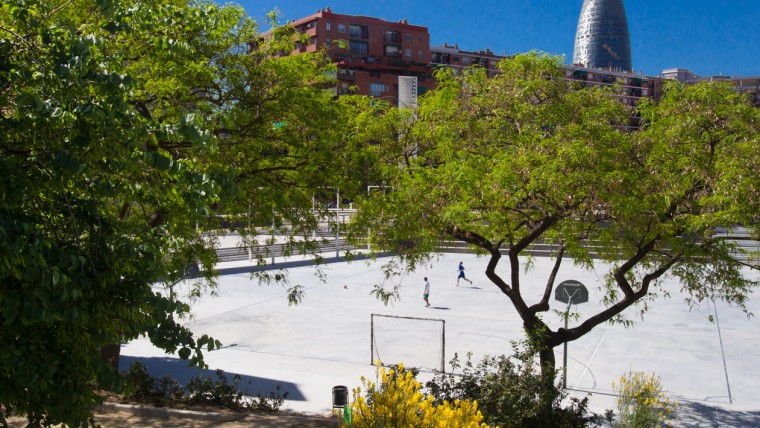
The park is divided into four very different parts: a long promenade and three large spaces with different uses. But it also has elements that promote a feeling of togetherness and continuity.

History
Parc del Clot was created by sinking the tracks to the RENFE workshops opened in 1858 but which had obviously closed.
Those railway lines and workshops had acted as a frontier in Sant Martí for over a century, separating its two nerve centres, the market and the town hall. Creating the park allowed them to be connected and Av Meridiana to be linked to Gran Via de les Corts Catalanes.
The park was planned in 1986, according to a design by Daniel Freixa and Vicent Miranda. They opted to preserve some of the old factory structures and what had previously been part of the El Clot station and the railway repair shops. These structures were integrated into the park, giving it a unique look. The remains of buildings, walls, windows, arches and the chimney stack mark out the various spaces. Some of these vestiges of the past were also integrated into the large square surrounded by steps, where the sports courts are.

Art and Architecture
Architectural features are very important in this park. The tall walls and large arcades of the old RENFE workshops are scattered around the site. A good part of these walls that once made up the facade are now one of the park’s most spectacular features: a 25-metre-long aqueduct which is set inside a lake and ends with a waterfall.
Inside a kind of square-shaped pavilion, also made from the walls of the old workshop, there is a sculpture by the North American sculptor Bryan Hunt, called Rites of Spring (1986). This is a bronze work over four metres high, depicting falling water. It stands in a pool and is completed by a small, pine-shaped fountain, also made of bronze and set in a small, circular pool by the pavilion structure.
Other striking features include two ornamental fountains, La Pinya (Pine Cone) and La Cascada (Waterfall). The latter, on the side of the park next to Carrer dels Escultors Claperós, was completely restored during the park’s last refurbishment, when the paving and landscaping were renovated. The former has also been fully restored and is one of the elements that gives the park its identity.
-
- Phone number
- Tel.: 010
-
- Accessibility
- Accessible for people with physical disabilities
-
- Titularity
- Public center
- Address:
- Escultors Claperós, 55*63
- Districte:
- Sant Martí
- Neighborhood:
- el Clot
- City:
- Barcelona
- Sections of this equipment
- Àrea de joc infantil Open in a new window
- Àrea de joc infantil Open in a new window
- Àrea de joc infantil Open in a new window
- Àrea de joc infantil Open in a new window
- Espai per a gossos deslligats al parc del clot Open in a new window
- Àrea d'esbarjo per a gossos Open in a new window
- Frontó Open in a new window
- Cistelles de bàsquet Open in a new window
- Circuit esportiu Open in a new window
- Taules de ping-pong Open in a new window
- Àrea de joc infantil Open in a new window
Esdeveniments
-
'Activa't als parcs' al Parc del Clot Open in a new window
Permanent event

